The Risk of Agricultural Land Abandonment as a Socioeconomic Challenge for the Development of Agriculture in the European Union
Abstract
1. Introduction
2. Literature Review
- poor environmental/biophysical suitability for agricultural activity;
- low farm stability and viability;
- negative drivers in the regional context.
- migration caused by military conflict, political instability, or large-scale natural disasters such as hurricanes [30];
- new production technologies, rapid industrialization, monopoly on land ownership, safety, availability of infrastructure, distance from potential markets [5];
- decrease in the biodiversity of agricultural landscapes and crop homogeneity associated with, for example, a higher risk of agricultural fires [3];
- depletion of water resources, loss of biodiversity, decrease in the population of species adapted to the local environmental conditions, loss of cultural and aesthetic values [3];
- historical events, such as the transition from a centrally planned to a market economy and the collapse of agriculture in Eastern European countries between 1990 and 2004; national and EU policies; problems with renewing agri-environmental contracts after five years; new sanitary requirements imposed on agricultural producers in Eastern Europe in 2004; decoupled payments that are not linked with production [8,24,31];
Agriculture Land Changes
3. Materials and Methods
Data Collection
- Choosing a set of variables
- 2.
- Construction of the taxonomic measure of risk using the Hellwig measurement method
- 3.
- Building a ranking of countries and their division into classes
- class I (low risk of farmland abandoning) ,
- class II (average risk of farmland abandoning) ,
- class III (high risk of farmland abandoning) ,
- 4.
- Regression
4. Results
5. Discussion and Conclusions
Author Contributions
Funding
Institutional Review Board Statement
Informed Consent Statement
Data Availability Statement
Conflicts of Interest
Appendix A

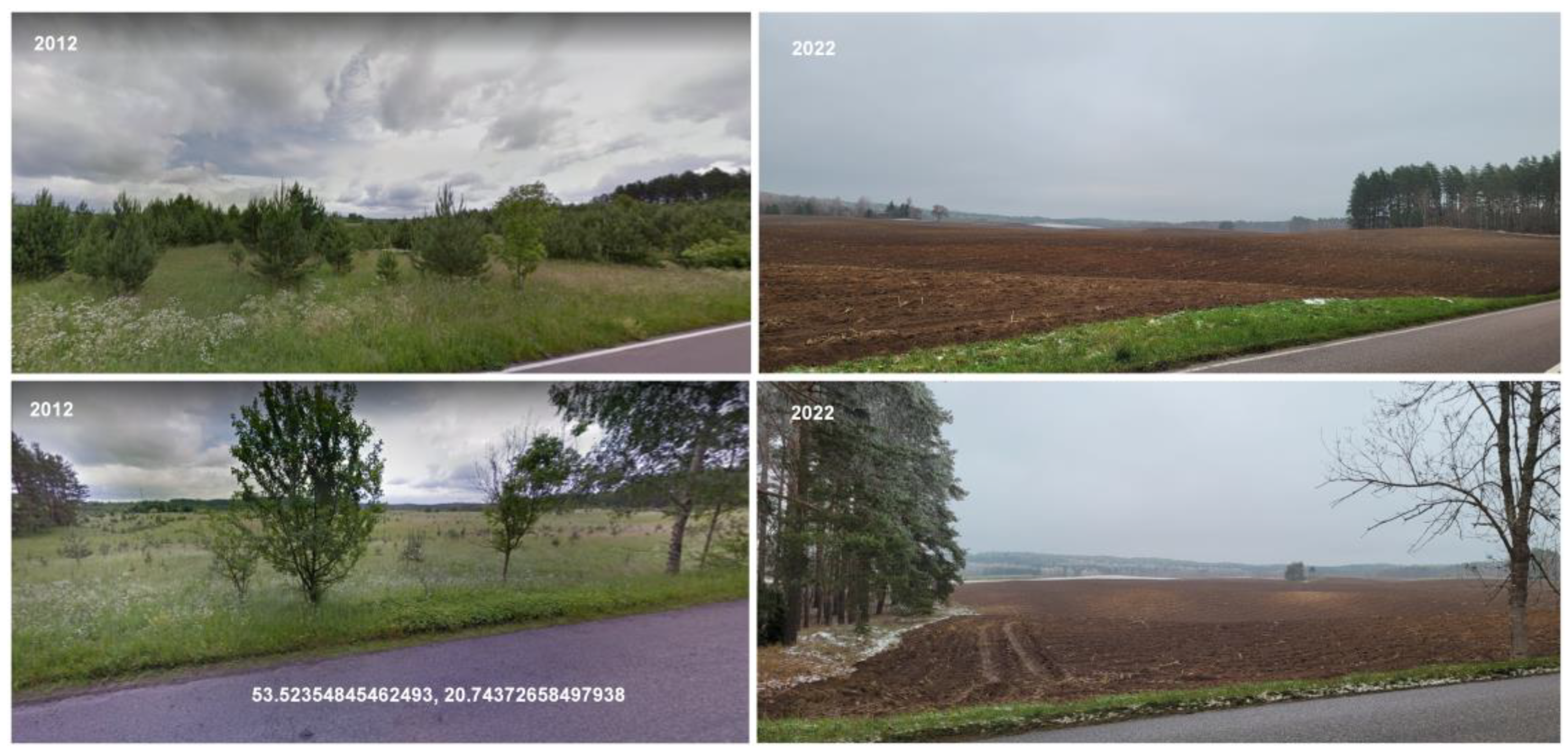
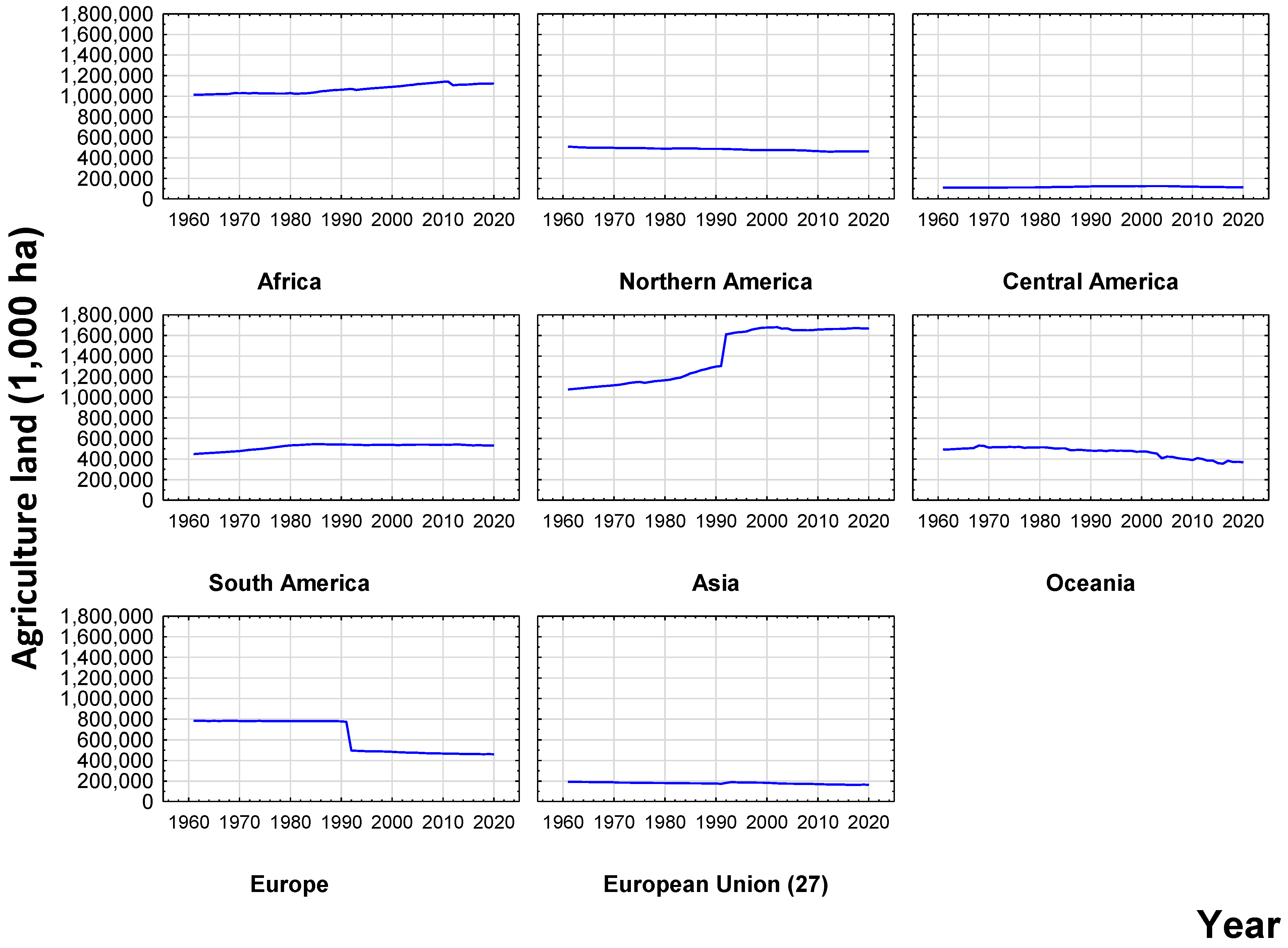
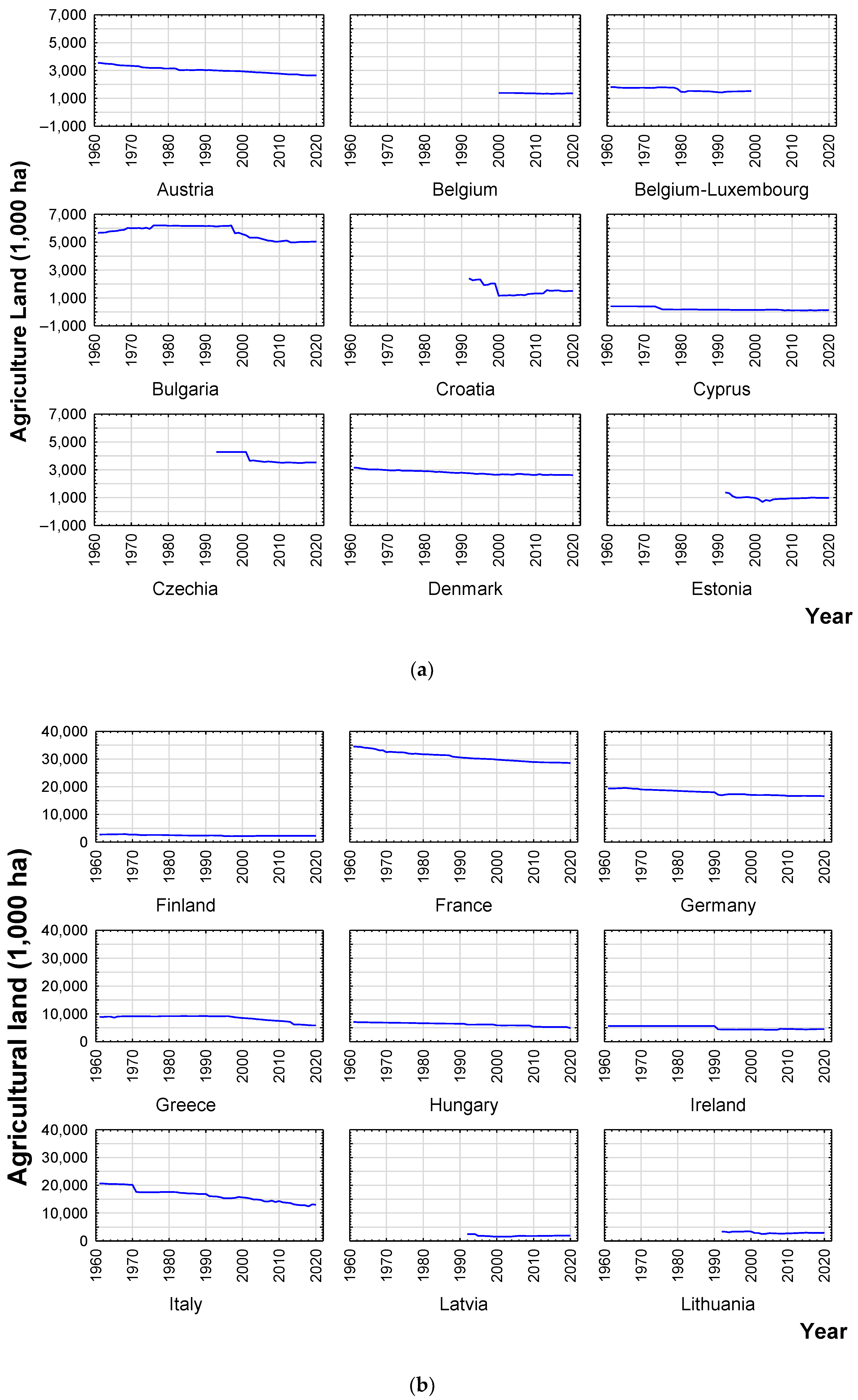

| Region | Regression Equation | p | r2 |
|---|---|---|---|
| Africa | y = −3,478,144 + 2284x | 0.0000 | 0.9097 |
| Northern America | y = 1,989,462 − 756x | 0.0000 | 0.9583 |
| Central America | y = −217,966 + 169x | 0.0000 | 0.3215 |
| South America | y = −2,080,185 + 1307x | 0.0000 | 0.5928 |
| Asia | y = −25,400,495 + 13,466x | 0.0000 | 0.8568 |
| Oceania | y = 5,701,947 − 2630x | 0.0000 | 0.7947 |
| Europe | y = 16,128,571 − 7785x | 0.0000 | 0.7812 |
| European Union (27) | y = 986,616 − 406x | 0.0000 | 0.7344 |
| Country | Regression Equation | p | r2 | Change ** |
|---|---|---|---|---|
| Austria | y = 30,785.6714 − 13.9407x | 0.0000 | 0.9702 | −25.56 |
| Belgium * | y = 19,679.1905 − 9.116x | 0.0000 | 0.8600 | −24.65 |
| Bulgaria | y = 89,659.8084 − 42.0122x | 0.0000 | 0.8765 | −18.36 |
| Croatia | y = 54,865.3825 − 26.5677x | 0.0015 | 0.3167 | −37.40 |
| Cyprus | y = 10,280.0523 − 5.0613x | 0.0000 | 0.6895 | −66.80 |
| Czechia | y = 77,247.8091 − 36.6115x | 0.0000 | 0.7438 | −17.71 |
| Denmark | y = 20,045.4118 − 8.6618x | 0.0000 | 0.9289 | −17.09 |
| Estonia | y = 11,475.1336 − 5.2341x | 0.0703 | 0.1163 | −28.31 |
| Finland | y = 24,068.9314 − 10.8637x | 0.0000 | 0.8060 | −17.92 |
| France | y = 2.3002 × 105 − 100.0331x | 0.0000 | 0.9685 | −17.33 |
| Germany | y = 1.2933 × 105 − 55.9978x | 0.0000 | 0.9474 | −14.35 |
| Greece | y = 1.0456 × 105 − 48.2826x | 0.0000 | 0.6363 | −34.15 |
| Hungary | y = 72,743.1583 − 33.4103x | 0.0000 | 0.9499 | −30.78 |
| Ireland | y = 64,141.9966 − 29.6907x | 0.0000 | 0.7123 | −20.13 |
| Italy | y = 2.7813 × 105 − 131.4762x | 0.0000 | 0.9468 | −37.15 |
| Latvia | y = 13,756.7232 − 5.9239x | 0.3041 | 0.0391 | −22.17 |
| Lithuania | y = 41,019.231 − 18.9517x | 0.0014 | 0.3184 | −13.17 |
| Luxembourg | y = −288.8289 + 0.2085x | 0.0000 | 0.7815 | 3.23 |
| Malta | y = 227.9085 − 0.1084x | 0.0000 | 0.7866 | −42.33 |
| Netherlands | y = 16,774.532 − 7.4168x | 0.0000 | 0.9168 | −21.59 |
| Poland | y = 2.2811 × 105 − 105.6308x | 0.0000 | 0.8591 | −28.84 |
| Portugal | y = 13,105.724 − 4.6431x | 0.0000 | 0.4343 | −0.06 |
| Romania | y = 60,078.3191 − 22.8643x | 0.0000 | 0.5923 | −6.92 |
| Slovakia | y = 55,807.7381 − 26.7671x | 0.0000 | 0.8086 | −23.02 |
| Slovenia | y = −8235.0307 + 4.3848x | 0.00003 | 0.4800 | 8.24 |
| Spain | y = 2.6407 × 105 − 117.557x | 0.0000 | 0.9516 | −21.33 |
| Sweden | y = 40,440.7114 − 18.5956x | 0.0000 | 0.9387 | −29.06 |
| Variable Code | Name | Data Source | Unit | Description | Role |
|---|---|---|---|---|---|
| D1 | Weak land market | [72] SE375/SE030 | €/ha | SE375. Rent paid for farm land and buildings and rental charges SE030. Utilized agricultural areas rented by the holder under a tenancy agreement for a period of at least one year (remuneration in cash or in kind); in hectares. High land sale and lease prices are generally associated with high demand for agricultural land, and thus with a lower risk of abandonment (the higher, the lower the risk of abandonment). | stimulant |
| D2 | Low farm income | [72,73] SE415/DGP per capita | € | SE451. Farm Net Value Added; Remuneration to the fixed factors of production (work, land and capital), whether they be external or family factors. As a result, holdings can be compared irrespective of their family/non-family nature of the factors of production employed. This indicator is sensitive, however, to the production methods employed: the ratio (intermediate consumption + depreciation)/fixed factors may vary and therefore influence the FNVA level. For example, in the livestock sector, if production is mostly without the use of land (purchased feed) or extensive (purchase and renting of forage land). SE415 is a weighted mean (average) calculated as a [sum of sample farm incomes x sample farm weights]/[sum of sample farm weights]. DGP per capita—Gross domestic product at market prices, Current prices, euro per capita. Agricultural land is at greater risk of abandonment when it ceases to generate sufficient income (the higher, the lower the risk of abandonment). | stimulant |
| D3 | Low investment in the farm | [72] SE521/SE025 | €/ha | SE521. Net Investment on fixed assets. Gross Investment on fixed assets—Depreciation. SE025. Total Utilized Agricultural Area. Total utilized agricultural area of holding. Does not include areas used for mushrooms, land rented for less than one year on an occasional basis, woodland and other farm areas (roads, ponds, non-farmed areas, etc.). It consists of land in owner occupation, rented land, land in share-cropping (remuneration linked to output from land made available). It includes agricultural land temporarily not under cultivation for agricultural reasons or being withdrawn from production as part of agricultural policy measures. It is expressed in hectares (10,000 m2). As from 2014, it includes kitchen gardens. Investment behavior reflects the dynamics of the farm, its adaptability and expectations for the future. New investments signal a medium/long-term strategy and can be an indicator of the desire to continue farming (the higher, the lower the risk of abandonment). | stimulant |
| D4 | Age of farm holder | [74] Age 65 and more/Total age | % | The ratio between farm holders above 65 years and the total number of farm holders has been calculated. Abandonment of farmland is more likely when the farmer population is older, close to retirement (the higher, the greater the risk of abandonment). | destimulant |
| D7a | Low population density | [75] Population density | person/km2 | Scarcely populated areas are identified from population statistics and were defined as areas with a population density below 50 inhabitants/km2. The higher the population density, the less likely agricultural land is to be abandoned | stimulant |
| D7b | Remoteness | [76] Road networks | km/km2 | Motorways and other roads per thousand square kilometers. Abandonment of agricultural land is likely to occur in remote areas with inadequate access to basic services (health care, school and other services) and fewer marketing opportunities (the higher up, the lower the risk of abandonment). | stimulant |
| N = 25 | b * | Std. Error with b * | b | Std. Error with b | t(23) | p |
|---|---|---|---|---|---|---|
| 2010 | R = 0.99629431 R2 = 0.99260235 Corrected. R2 = 0.99013646 F(6,18) = 402.53 p < 0.00000 std. error: 0.01503 | |||||
| Intersept | 0.139 | 0.008 | 16.887 | 0.0000 | ||
| D1 | 0.289 | 0.034 | 0.0004 | 0.00005 | 8.373 | 0.0000 |
| D2 | 0.245 | 0.026 | 0.0003 | 0.00003 | 9.589 | 0.0000 |
| D3 | −0.176 | 0.022 | −0.0017 | 0.0002 | −8.128 | 0.0000 |
| D4 | 0.298 | 0.027 | 0.0003 | 0.00002 | 10.866 | 0.0000 |
| D7a | 0.265 | 0.032 | 0.00004 | 0.000005 | 8.217 | 0.0000 |
| D7b | 0.168 | 0.024 | 0.0161 | 0.0023 | 7.124 | 0.0000 |
| 2013 | R = 0.99288540 R2 = 0.98582142 Corrected. R2 = 0.98109523 F(6,18) = 208.59 p < 0.00000 std. error: 0.01811 | |||||
| Intersept | 0.126425 | 0.00896 | 14.11051 | 0.000000 | ||
| D1 | 0.2561 | 0.049056 | 0.000305 | 0.000059 | 5.22055 | 0.000058 |
| D2 | 0.28482 | 0.039563 | 0.00022 | 0.000031 | 7.1992 | 0.000001 |
| D3 | −0.184943 | 0.028719 | −0.001711 | 0.000266 | −6.43984 | 0.000005 |
| D4 | 0.292759 | 0.041806 | 0.000184 | 0.000026 | 7.00279 | 0.000002 |
| D7a | 0.227376 | 0.030905 | 0.011945 | 0.001624 | 7.35716 | 0.000001 |
| D7b | 0.224572 | 0.046893 | 0.000029 | 0.000006 | 4.789 | 0.000147 |
| 2016 | R = 0.98691592 R2 = 0.97400304 Corrected. R2 = 0.96533739 F(6,18) = 112.40 p < 0.00000 std. error: 0.02043 | |||||
| Intersept | 0.108666 | 0.009221 | 11.78459 | 0.000000 | ||
| D1 | 0.281342 | 0.066686 | 0.000276 | 0.000065 | 4.21893 | 0.000516 |
| D2 | 0.319762 | 0.042822 | 0.000282 | 0.000038 | 7.46728 | 0.000001 |
| D3 | 0.288382 | 0.039478 | 0.009957 | 0.001363 | 7.30489 | 0.000001 |
| D4 | 0.349819 | 0.05475 | 0.000176 | 0.000027 | 6.38936 | 0.000005 |
| D7a | −0.214998 | 0.038488 | −0.001699 | 0.000304 | −5.58606 | 0.000027 |
| D7b | 0.208994 | 0.062852 | 0.000023 | 0.000007 | 3.32519 | 0.003766 |
| 2019 | R = 0.99398472 R2 = 0.98800563 Corrected. R2 = 0.98400751 F(6,18) = 247.12 p < 0.00000 std. error: 0.01613 | |||||
| Intersept | 0.119548 | 0.009112 | 13.12017 | 0.000000 | ||
| D1 | 0.240778 | 0.045427 | 0.000271 | 0.000051 | 5.30037 | 0.000049 |
| D2 | 0.279099 | 0.04781 | 0.000197 | 0.000034 | 5.83769 | 0.000016 |
| D3 | −0.176622 | 0.026478 | −0.001409 | 0.000211 | −6.6704 | 0.000003 |
| D4 | 0.218311 | 0.027317 | 0.011527 | 0.001442 | 7.99184 | 0.000000 |
| D7a | 0.292289 | 0.039854 | 0.000173 | 0.000024 | 7.33394 | 0.000001 |
| D7b | 0.222805 | 0.047874 | 0.000028 | 0.000006 | 4.65399 | 0.000197 |
References
- Ramankutty, N.; Foley, J.A. Estimating Historical Changes in Global Land Cover: Croplands from 1700 to 1992. Glob. Biogeochem. Cycles 1999, 13, 997–1027. [Google Scholar] [CrossRef]
- Berardi, G.; Green, R.; Hammond, B. Stability, Sustainability, and Catastrophe: Applying Resilience Thinking to U. S. Agriculture. Hum. Ecol. Rev. 2011, 18, 115–125. [Google Scholar]
- Leal Filho, W.; Mandel, M.; Al-Amin, A.Q.; Feher, A.; Chiappetta Jabbour, C.J. An Assessment of the Causes and Consequences of Agricultural Land Abandonment in Europe. Int. J. Sustain. Dev. World Ecol. 2017, 24, 554–560. [Google Scholar] [CrossRef]
- Estel, S.; Kuemmerle, T.; Alcántara, C.; Levers, C.; Prishchepov, A.; Hostert, P. Mapping Farmland Abandonment and Recultivation across Europe Using MODIS NDVI Time Series. Remote Sens. Environ. 2015, 163, 312–325. [Google Scholar] [CrossRef]
- Rey Benayas, J.M.; Martins, A.; Nicolau, J.M.; Schulz, J.J. Abandonment of Agricultural Land: An Overview of Drivers and Consequences. CABI Rev. 2007, 2, 14. [Google Scholar] [CrossRef]
- Keenleyside, C.; Tucker, G. Farmland Abandonment in the EU: An Assessment of Trends and Prospects; Report Prepared for WWF; Institute for European Environmental Policy: London, UK, 2010; p. 97. [Google Scholar]
- Lasanta, T.; Arnáez, J.; Pascual, N.; Ruiz-Flaño, P.; Errea, M.P.; Lana-Renault, N. Space–Time Process and Drivers of Land Abandonment in Europe. CATENA 2017, 149, 810–823. [Google Scholar] [CrossRef]
- Anguiano, E.; Bamps, C.; Terres, J.; Pointereau, P.; Coulon, F.; Girard, P.; Lambotte, M.; Stuczynski, T.; Sanchez Ortega, V.; Del Rio, A. Analysis of Farmland Abandonment and the Extent and Location of Agricultural Areas That Are Actually Abandoned or Are in Risk to Be Abandoned; Institute for Environment and Sustainability: Luxembourg, 2008. [Google Scholar]
- Terres, J.-M.; Scacchiafichi, L.N.; Wania, A.; Ambar, M.; Anguiano, E.; Buckwell, A.; Coppola, A.; Gocht, A.; Källström, H.N.; Pointereau, P.; et al. Farmland Abandonment in Europe: Identification of Drivers and Indicators, and Development of a Composite Indicator of Risk. Land Use Policy 2015, 49, 20–34. [Google Scholar] [CrossRef]
- Levers, C.; Schneider, M.; Prishchepov, A.V.; Estel, S.; Kuemmerle, T. Spatial Variation in Determinants of Agricultural Land Abandonment in Europe. Sci. Total Environ. 2018, 644, 95–111. [Google Scholar] [CrossRef]
- Perpiña Castillo, C.; Coll Aliaga, E.; Lavalle, C.; Martínez Llario, J.C. An Assessment and Spatial Modelling of Agricultural Land Abandonment in Spain (2015–2030). Sustainability 2020, 12, 560. [Google Scholar] [CrossRef]
- Zhang, Y.; Li, X.; Song, W. Determinants of Cropland Abandonment at the Parcel, Household and Village Levels in Mountain Areas of China: A Multi-Level Analysis. Land Use Policy 2014, 41, 186–192. [Google Scholar] [CrossRef]
- Sroka, W.; Pölling, B.; Wojewodzic, T.; Strus, M.; Stolarczyk, P.; Podlinska, O. Determinants of Farmland Abandonment in Selected Metropolitan Areas of Poland: A Spatial Analysis on the Basis of Regression Trees and Interviews with Experts. Sustainability 2019, 11, 3071. [Google Scholar] [CrossRef]
- Vinogradovs, I.; Nikodemus, O.; Elferts, D.; Brūmelis, G. Assessment of Site-Specific Drivers of Farmland Abandonment in Mosaic-Type Landscapes: A Case Study in Vidzeme, Latvia. Agric. Ecosyst. Environ. 2018, 253, 113–121. [Google Scholar] [CrossRef]
- Quintas-Soriano, C.; Buerkert, A.; Plieninger, T. Effects of Land Abandonment on Nature Contributions to People and Good Quality of Life Components in the Mediterranean Region: A Review. Land Use Policy 2022, 116, 106053. [Google Scholar] [CrossRef]
- Alcantara, C.; Kuemmerle, T.; Prishchepov, A.V.; Radeloff, V.C. Mapping Abandoned Agriculture with Multi-Temporal MODIS Satellite Data. Remote Sens. Environ. 2012, 124, 334–347. [Google Scholar] [CrossRef]
- Zhou, Z.; Duan, J.; Li, W.; Geng, S. Can Rural Road Construction Promote the Sustainable Development of Regional Agriculture in China? Sustainability 2021, 13, 10882. [Google Scholar] [CrossRef]
- Han, Z.; Song, W. Abandoned Cropland: Patterns and Determinants within the Guangxi Karst Mountainous Area, China. Appl. Geogr. 2020, 122, 102245. [Google Scholar] [CrossRef]
- van der Zanden, E.H.; Verburg, P.H.; Schulp, C.J.E.; Verkerk, P.J. Trade-Offs of European Agricultural Abandonment. Land Use Policy 2017, 62, 290–301. [Google Scholar] [CrossRef]
- Paudel, B.; Wu, X.; Zhang, Y.; Rai, R.; Liu, L.; Zhang, B.; Khanal, N.R.; Koirala, H.L.; Nepal, P. Farmland Abandonment and Its Determinants in the Different Ecological Villages of the Koshi River Basin, Central Himalayas: Synergy of High-Resolution Remote Sensing and Social Surveys. Environ. Res. 2020, 188, 109711. [Google Scholar] [CrossRef]
- FAOSTAT Land Use. Available online: https://www.fao.org/faostat/en/#data/RL (accessed on 2 September 2022).
- Corbelle-Rico, E.; Crecente-Maseda, R. Evaluating IRENA Indicator “Risk of Farmland Abandonment” on a Low Spatial Scale Level: The Case of Galicia (Spain). Land Use Policy 2014, 38, 9–15. [Google Scholar] [CrossRef]
- Li, S.; Li, X. Global Understanding of Farmland Abandonment: A Review and Prospects. J. Geogr. Sci. 2017, 27, 1123–1150. [Google Scholar] [CrossRef]
- Prishchepov, A.V.; Radeloff, V.C.; Baumann, M.; Kuemmerle, T.; Müller, D. Effects of Institutional Changes on Land Use: Agricultural Land Abandonment during the Transition from State-Command to Market-Driven Economies in Post-Soviet Eastern Europe. Environ. Res. Lett. 2012, 7, 024021. [Google Scholar] [CrossRef]
- FAO. The Role of Agriculture and Rural Development in Revitalizing Abandoned/Depopulated Areas; FAO; The European Commission on Agriculture: Riga, Latvia, 2006; p. 15. [Google Scholar]
- Cramer, V.A.; Hobbs, R.J.; Standish, R.J. What’s New about Old Fields? Land Abandonment and Ecosystem Assembly. Trends Ecol. Evol. 2008, 23, 104–112. [Google Scholar] [CrossRef] [PubMed]
- Nisini, L.; Anguiano, E.; Terres, J.-M. Assessing the Risk of Farmland Abandonment in the EU; JRC Scientific and Policy Reports; European Commission. Joint Research Centre. Institute for Environment and Sustainability: Luxembourg, 2013; p. 134. [Google Scholar]
- Hou, D.; Meng, F.; Prishchepov, A.V. How Is Urbanization Shaping Agricultural Land-Use? Unraveling the Nexus between Farmland Abandonment and Urbanization in China. Landsc. Urban Plan. 2021, 214, 104170. [Google Scholar] [CrossRef]
- Achieng, T.; Maciejewski, K.; Dyer, M.; Biggs, R. Using a Social-Ecological Regime Shift Approach to Understand the Transition from Livestock to Game Farming in the Eastern Cape, South Africa. Land 2020, 9, 97. [Google Scholar] [CrossRef]
- Aide, T.M.; Grau, H.R. Globalization, Migration, and Latin American Ecosystems. Science 2004, 305, 1915–1916. [Google Scholar] [CrossRef] [PubMed]
- Kuemmerle, T.; Hostert, P.; Radeloff, V.C.; Van Der Linden, S.; Perzanowski, K.; Kruhlov, I. Cross-Border Comparison of Post-Socialist Farmland Abandonment in the Carpathians. Ecosystems 2008, 11, 614–628. [Google Scholar] [CrossRef]
- Munroe, D.K.; van Berkel, D.B.; Verburg, P.H.; Olson, J.L. Alternative Trajectories of Land Abandonment: Causes, Consequences and Research Challenges. Curr. Opin. Environ. Sustain. 2013, 5, 471–476. [Google Scholar] [CrossRef]
- Milenov, P.; Vassilev, V.; Vassileva, A.; Radkov, R.; Samoungi, V.; Dimitrov, Z.; Vichev, N. Monitoring of the Risk of Farmland Abandonment as an Efficient Tool to Assess the Environmental and Socio-Economic Impact of the Common Agriculture Policy. Int. J. Appl. Earth Obs. Geoinf. 2014, 32, 218–227. [Google Scholar] [CrossRef]
- Renwick, A.; Jansson, T.; Verburg, P.H.; Revoredo-Giha, C.; Britz, W.; Gocht, A.; McCracken, D. Policy Reform and Agricultural Land Abandonment in the EU. Land Use Policy 2013, 30, 446–457. [Google Scholar] [CrossRef]
- van Leeuwen, C.C.E.; Cammeraat, E.L.H.; de Vente, J.; Boix-Fayos, C. The Evolution of Soil Conservation Policies Targeting Land Abandonment and Soil Erosion in Spain: A Review. Land Use Policy 2019, 83, 174–186. [Google Scholar] [CrossRef]
- Pawlewicz, A.; Pawlewicz, K. Regional Differences in Agricultural Production Potential in the European Union Member States. In Proceedings of the Rural Development and Entrepreneurship Production and Co-Operation in Agriculture; Auzina, A., Ed.; Latvia Univ Agriculture: Jelgava, Latvia, 2018; Volume 47, pp. 483–489. [Google Scholar]
- Bürgi, M.; Hersperger, A.M.; Schneeberger, N. Driving Forces of Landscape Change—Current and New Directions. Landsc. Ecol. 2004, 19, 857–868. [Google Scholar] [CrossRef]
- Pawlewicz, A.; Cieslak, I.; Pawlewicz, K.; Szuniewicz, K. Natura 2000 Sites and Socio-Economic Development of Rural Communes in Eastern Poland. In Proceedings of the Economic Science for Rural Development: Integrated and Sustainable Regional Development; Kusis, J., Ed.; Latvia Univ Life Sciences & Technologies: Jelgava, Latvia, 2015; pp. 14–23. [Google Scholar]
- Elbakidze, M.; Angelstam, P. Implementing Sustainable Forest Management in Ukraine’s Carpathian Mountains: The Role of Traditional Village Systems. For. Ecol. Manag. 2007, 249, 28–38. [Google Scholar] [CrossRef]
- Grădinaru, S.R.; Iojă, C.I.; Onose, D.A.; Gavrilidis, A.A.; Pătru-Stupariu, I.; Kienast, F.; Hersperger, A.M. Land Abandonment as a Precursor of Built-up Development at the Sprawling Periphery of Former Socialist Cities. Ecol. Indic. 2015, 57, 305–313. [Google Scholar] [CrossRef]
- Perpiña Castillo, C.; Jacobs-Crisioni, C.; Diogo, V.; Lavalle, C. Modelling Agricultural Land Abandonment in a Fine Spatial Resolution Multi-Level Land-Use Model: An Application for the EU. Environ. Model. Softw. 2021, 136, 104946. [Google Scholar] [CrossRef] [PubMed]
- Hart, K.; Allen, K.; Lindner, M.; Keenleyside, C.; Burgess, P.J.; Eggers, J.; Buckwell, A. Land as an Environmental Resource; Report Prepared for DG Environment, Contract No ENV.B.1/ETU/2011/0029; Institute for European Environmental Policy: London, UK, 2013. [Google Scholar]
- Höchtl, F.; Lehringer, S.; Konold, W. “Wilderness”: What It Means When It Becomes a Reality—A Case Study from the Southwestern Alps. Landsc. Urban Plan. 2005, 70, 85–95. [Google Scholar] [CrossRef]
- Moreira, F.; Russo, D. Modelling the Impact of Agricultural Abandonment and Wildfires on Vertebrate Diversity in Mediterranean Europe. Landsc. Ecol. 2007, 22, 1461–1476. [Google Scholar] [CrossRef]
- Dubinin, M.; Potapov, P.; Lushchekina, A.; Radeloff, V.C. Reconstructing Long Time Series of Burned Areas in Arid Grasslands of Southern Russia by Satellite Remote Sensing. Remote Sens. Environ. 2010, 114, 1638–1648. [Google Scholar] [CrossRef]
- Schierhorn, F.; Kastner, T.; Kuemmerle, T.; Meyfroidt, P.; Kurganova, I.; Prishchepov, A.V.; Erb, K.-H.; Houghton, R.A.; Müller, D. Large Greenhouse Gas Savings Due to Changes in the Post-Soviet Food Systems. Environ. Res. Lett. 2019, 14, 065009. [Google Scholar] [CrossRef]
- Gellrich, M.; Baur, P.; Koch, B.; Zimmermann, N.E. Agricultural Land Abandonment and Natural Forest Re-Growth in the Swiss Mountains: A Spatially Explicit Economic Analysis. Agric. Ecosyst. Environ. 2007, 118, 93–108. [Google Scholar] [CrossRef]
- Baldock, D.; Selby, A.; Holland; van Landbouw, M.; Visserij, N. Farming at the Margins: Abandonment or Redeployment of Agricultural Land in Europe; Institute for European Environmental Policy: Brussels, Belgium, 1996. [Google Scholar]
- Mather, A. The Transition from Deforestation to Reforestation in Europe. In Agricultural Technologies and Tropical Deforestation; CAB International: Wallingford, UK, 2001; pp. 35–52. [Google Scholar]
- Kolecka, N.; Kozak, J.; Kaim, D.; Dobosz, M.; Ostafin, K.; Ostapowicz, K.; Wężyk, P.; Price, B. Understanding Farmland Abandonment in the Polish Carpathians. Appl. Geogr. 2017, 88, 62–72. [Google Scholar] [CrossRef]
- Perpiña Castillo, C.; Kavalov, B.; Diogo, V.; Jacobs-Crisioni, C.; e Silva, F.B.; Lavalle, C. Agricultural Land Abandonment in the EU within 2015–2030. JRC Res. Rep. 2018. Available online: https://joint-research-centre.ec.europa.eu/system/files/2018-12/jrc113718.pdf (accessed on 1 January 2023).
- EUROSTAT Agri-Environmental Indicator—Risk of Land Abandonment. Available online: https://ec.europa.eu/eurostat/statistics-explained/index.php?title=Archive:Agri-environmental_indicator_-_risk_of_land_abandonment (accessed on 5 December 2022).
- Kuropka, I. Prognozowanie na podstawie modelu ekonometrycznego. In Prognozowanie Gospodarcze. Metody i Zastosowanie; Cieślik, M., Ed.; PWN: Warszawa, Poland, 2001; pp. 104–139. ISBN 83-01-13347-3. [Google Scholar]
- Milenkovic, N.; Vukmirovic, J.; Bulajic, M.; Radojicic, Z. A Multivariate Approach in Measuring Socio-Economic Development of MENA Countries. Econ. Model. 2014, 38, 604–608. [Google Scholar] [CrossRef]
- del Holgado Molina, M.M.; Salinas Fernandez, J.A.; Rodriguez Martin, J.A. A Synthetic Indicator to Measure the Economic and Social Cohesion of the Regions of Spain and Portugal. Rev. De Econ. Mund. 2015, 39, 223–239. [Google Scholar]
- Pérez, A.G.; Hernández-López, M.; Echeverria, F.R. Sustainable Development Synthetic Indicators Based on Distance for Venezuela; Bulucea, A., Ed.; WSEAS Press: Rome, Italy, 2015; Volume 42, pp. 194–200. [Google Scholar]
- Ding, L.; Shao, Z.; Zhang, H.; Xu, C.; Wu, D. A Comprehensive Evaluation of Urban Sustainable Development in China Based on the TOPSIS-Entropy Method. Sustainability 2016, 8, 746. [Google Scholar] [CrossRef]
- Fura, B.; Wang, Q. The Level of Socioeconomic Development of EU Countries and the State of ISO 14001 Certification. Qual. Quant. 2017, 51, 103–119. [Google Scholar] [CrossRef] [PubMed]
- Hellwig, Z.H. Zastosowanie Metody Taksonomicznej Do Typologicznego Podziału Krajów Ze Względu Na Poziom Ich Rozwoju Oraz Zasoby i Strukturę Wykwalifikowanych Kadr. Przegląd Stat. 1968, 4, 307–327. [Google Scholar]
- Wysocki, F. Metody Taksonomiczne w Rozpoznawaniu Typów Ekonomicznych Rolnictwa i Obszarów Wiejskich; Uniwersytet Przyrodniczy w Poznaniu: Poznań, Poland, 2010; ISBN 978-83-7160-583-3. [Google Scholar]
- Pawlewicz, K. Differences in Development Levels of Urban Gminas in the Warminsko-Mazurskie Voivodship in View of the Main Components of Sustainable Development. Bull. Geogr. -Socio-Econ. Ser. 2015, 29, 93–102. [Google Scholar] [CrossRef]
- Liu, X.; Zeng, F. Poverty Reduction in China: Does the Agricultural Products Circulation Infrastructure Matter in Rural and Urban Areas? Agriculture 2022, 12, 1208. [Google Scholar] [CrossRef]
- Van Cauwenbergh, N.; Biala, K.; Bielders, C.; Brouckaert, V.; Franchois, L.; Cidad, V.G.; Hermy, M.; Mathijs, E.; Muys, B.; Reijnders, J.; et al. SAFE—A Hierarchical Framework for Assessing the Sustainability of Agricultural Systems. Agric. Ecosyst. Environ. 2007, 120, 229–242. [Google Scholar] [CrossRef]
- Parysek, J.J.; Wojtasiewicz, L. Metody Analizy Regionalnej i Metody Planowania Regionalnego; Studia/Polska Akademia Nauk. Komitet Przestrzennego Zagospodarowania Kraju, t. 69; Państwowe Wydawnictwo Naukowe: Warszawa, Poland, 1979; ISBN 83-01-01219-6. [Google Scholar]
- Kobe, I.H.; Olamide, O.E.; Bamidele, F.S.; Benedict, A.T.; Yemisi, B.K.; Kamal, D.A. Economic Assessment of Agricultural Land Market in Rural Nigeria: Pattern and Drivers. J. Land Rural. Stud. 2018, 6, 50–66. [Google Scholar] [CrossRef]
- Ciaian, P.; Swinnen, J.F.M. Credit Market Imperfections and the Distribution of Policy Rents. Am. J. Agric. Econ. 2009, 91, 1124–1139. [Google Scholar] [CrossRef]
- Pawlewicz, A.; Gotkiewicz, W.; Brodzińska, K.; Pawlewicz, K.; Mickiewicz, B.; Kluczek, P. Organic Farming as an Alternative Maintenance Strategy in the Opinion of Farmers from Natura 2000 Areas. Int. J. Environ. Res. Public Health 2022, 19, 3793. [Google Scholar] [CrossRef] [PubMed]
- Rickebusch, S.; Gellrich, M.; Lischke, H.; Guisan, A.; Zimmermann, N.E. Combining Probabilistic Land-Use Change and Tree Population Dynamics Modelling to Simulate Responses in Mountain Forests. Ecol. Model. 2007, 209, 157–168. [Google Scholar] [CrossRef]
- Kalinowska, B.; Bórawski, P.; Bełdycka-Bórawska, A.; Klepacki, B.; Perkowska, A.; Rokicki, T. Sustainable Development of Agriculture in Member States of the European Union. Sustainability 2022, 14, 4184. [Google Scholar] [CrossRef]
- Ziliaskopoulos, K.; Papalamprou, K. A Bilevel Linear Programming Model for Developing a Subsidy Policy to Minimize the Environmental Impact of the Agricultural Sector. Sustainability 2022, 14, 7651. [Google Scholar] [CrossRef]
- MacDonald, D.; Crabtree, J.R.; Wiesinger, G.; Dax, T.; Stamou, N.; Fleury, P.; Gutierrez Lazpita, J.; Gibon, A. Agricultural Abandonment in Mountain Areas of Europe: Environmental Consequences and Policy Response. J. Environ. Manag. 2000, 59, 47–69. [Google Scholar] [CrossRef]
- FADN. The Farm Accountancy Data Network (FADN)—The Standard Results Database. Available online: https://agridata.ec.europa.eu/extensions/FarmEconomyFocus/FarmEconomyFocus.html (accessed on 27 July 2022).
- EUROSTAT Main GDP Aggregates per Capita. Available online: https://ec.europa.eu/eurostat/databrowser/view/NAMA_10_PC/default/table?lang=en (accessed on 5 December 2022).
- EUROSTAT Employment by Sex, Age and Detailed Economic Activity (from 2008 Onwards, NACE Rev. 2 Two Digit Level)—1 000. Available online: https://ec.europa.eu/eurostat/databrowser/bookmark/582115c1-41fc-4c56-992c-ad2a9459ec53?lang=en (accessed on 5 December 2022).
- EUROSTAT Population Density by NUTS 3 Region. Available online: https://ec.europa.eu/eurostat/databrowser/view/DEMO_R_D3DENS/default/table?lang=en (accessed on 5 December 2022).
- EUROSTAT Road, Rail and Navigable Inland Waterways Networks by NUTS 2 Regions. Available online: https://ec.europa.eu/eurostat/databrowser/view/TRAN_R_NET/default/table?lang=en (accessed on 5 December 2022).
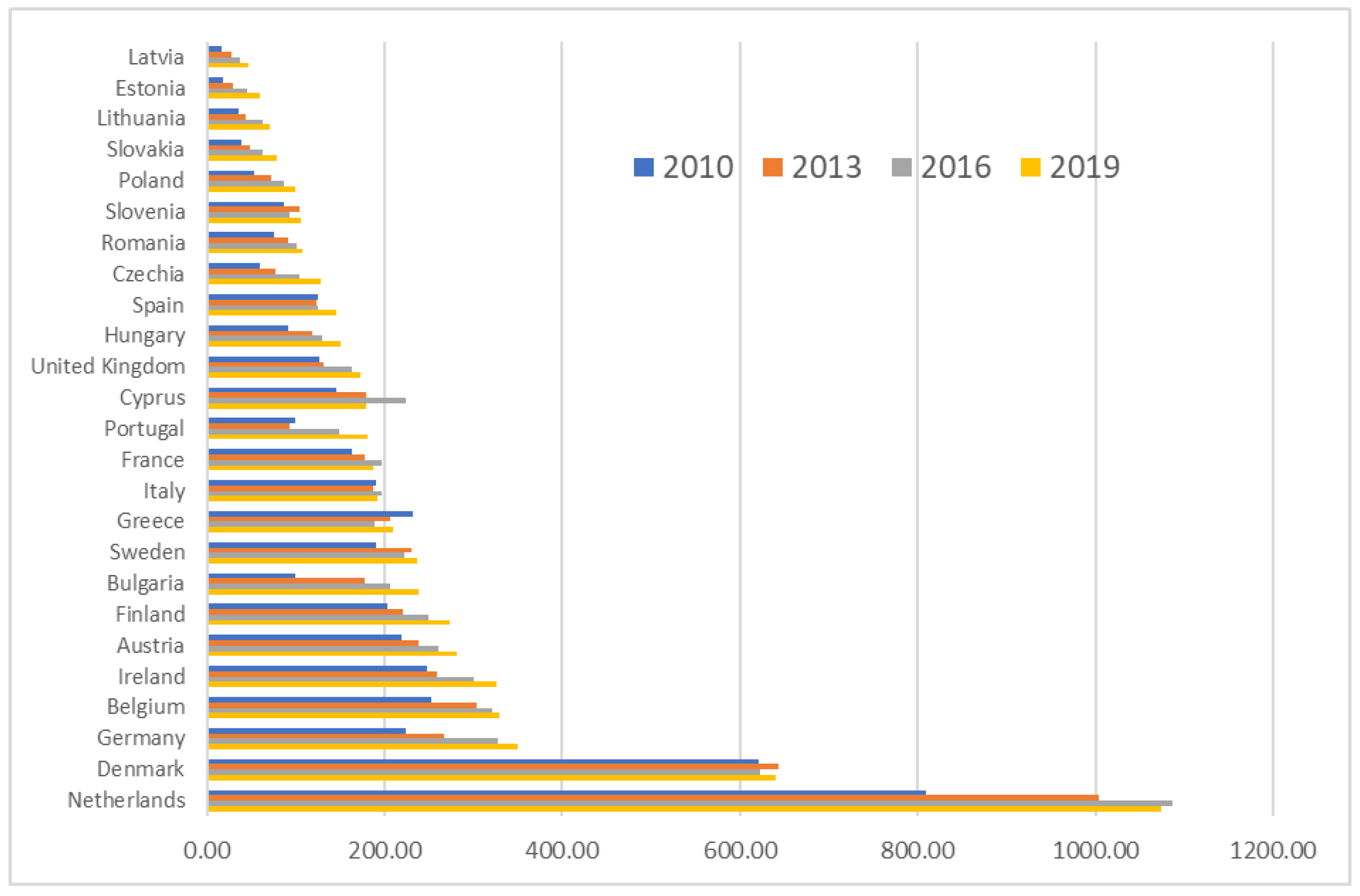
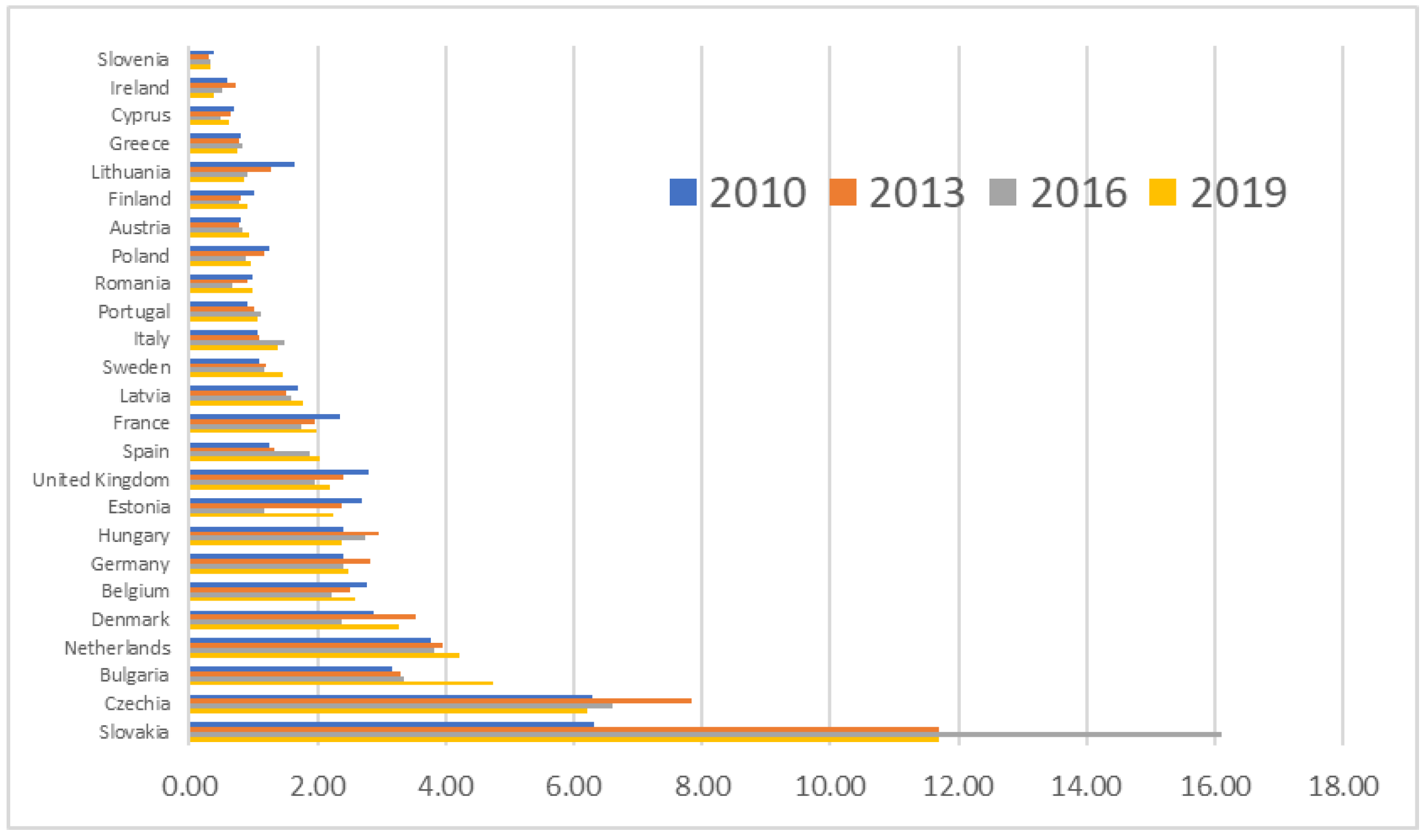
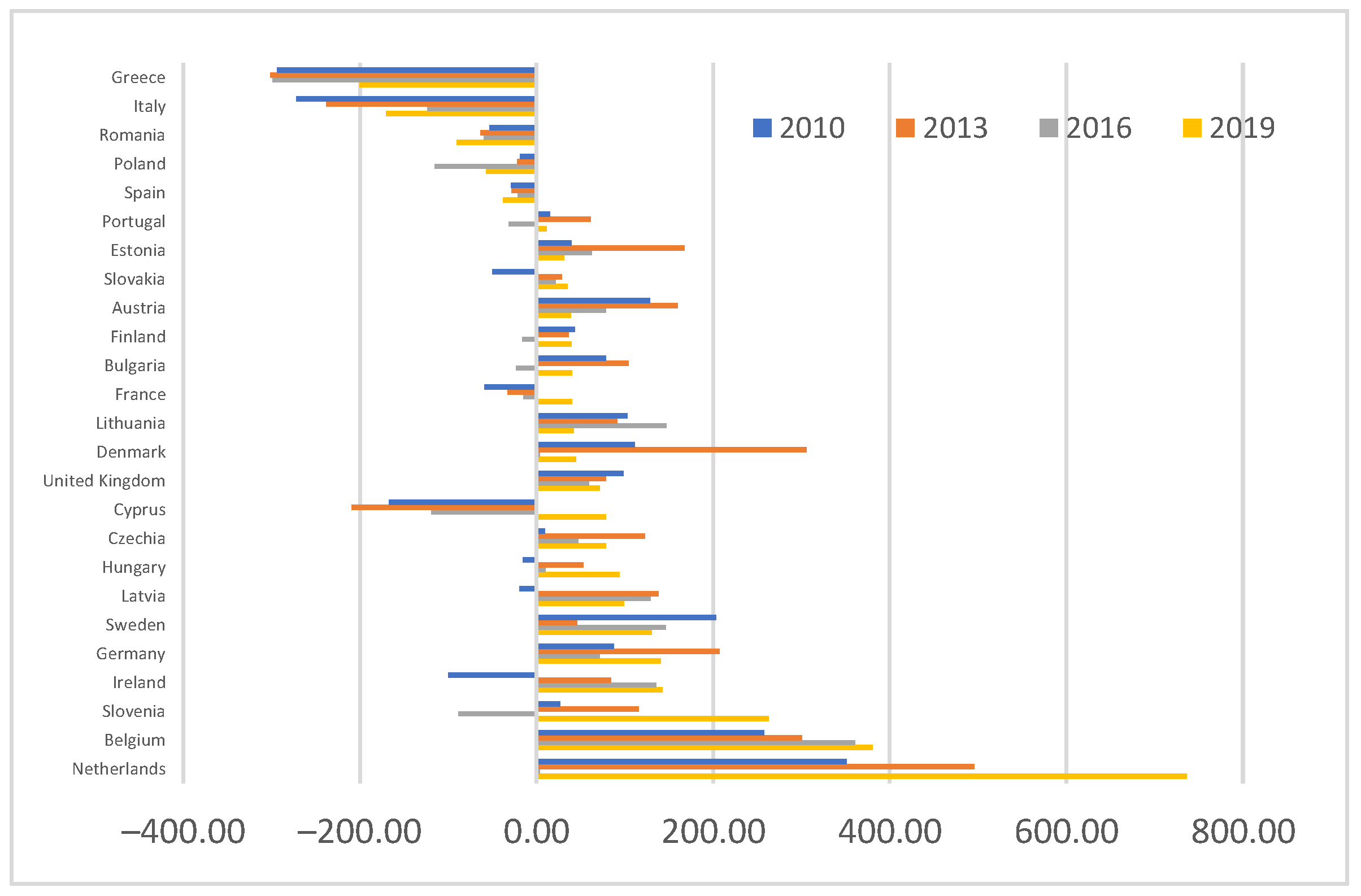
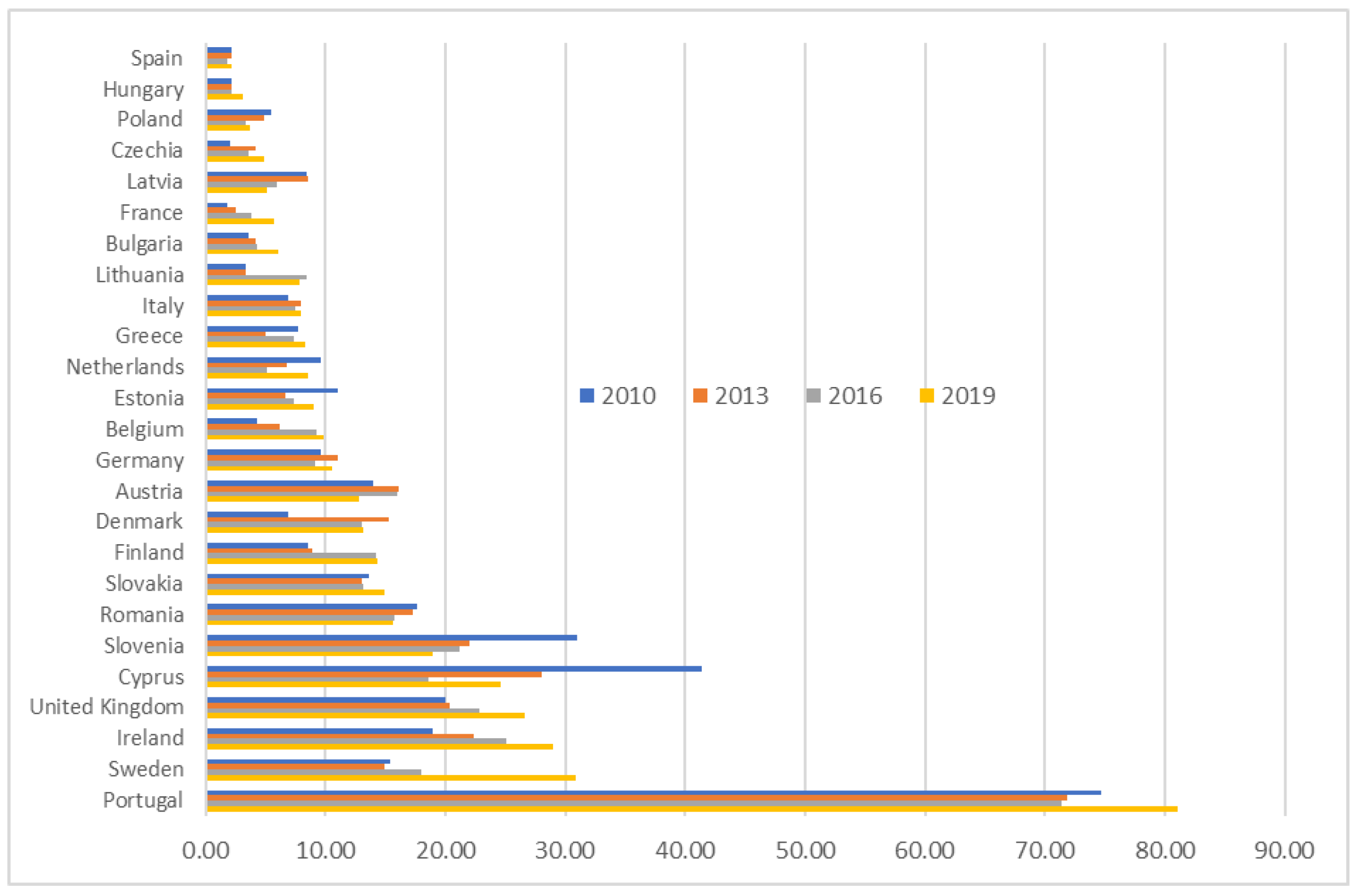

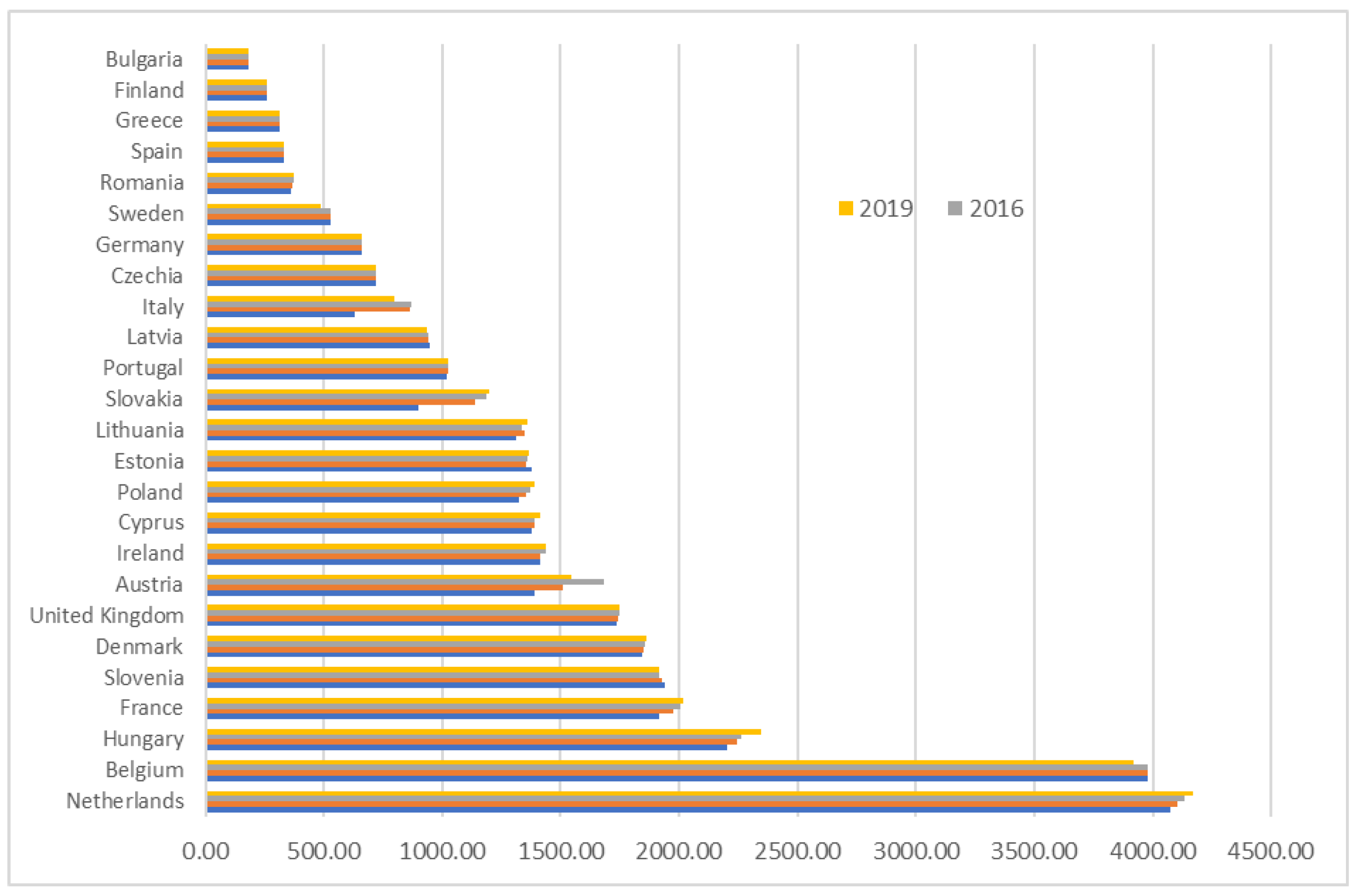
| 2010 | 2013 | 2016 | 2019 | |
|---|---|---|---|---|
| Belgium | I | I | I | I |
| Bulgaria | II | II | II | II |
| Czechia | II | II | II | II |
| Denmark | I | I | I | I |
| Germany | I | I | I | I |
| Estonia | II | II | III | II |
| Ireland | II | II | II | II |
| Greece | III | III | III | III |
| Spain | III | III | III | III |
| France | II | II | II | II |
| Italy | III | III | II | III |
| Cyprus | III | III | III | II |
| Latvia | III | III | II | III |
| Lithuania | II | II | II | III |
| Hungary | II | II | II | II |
| Netherlands | I | I | I | I |
| Austria | II | II | II | II |
| Poland | II | II | III | II |
| Portugal | III | III | III | III |
| Romania | III | III | III | III |
| Slovenia | II | II | III | II |
| Slovakia | II | II | I | II |
| Finland | III | III | III | III |
| Sweden | II | III | II | III |
| United Kingdom | I | II | I | II |
| Legend | ||||
| Class I (low risk) | Class II (average risk) | Class III (high risk) | ||
Disclaimer/Publisher’s Note: The statements, opinions and data contained in all publications are solely those of the individual author(s) and contributor(s) and not of MDPI and/or the editor(s). MDPI and/or the editor(s) disclaim responsibility for any injury to people or property resulting from any ideas, methods, instructions or products referred to in the content. |
© 2023 by the authors. Licensee MDPI, Basel, Switzerland. This article is an open access article distributed under the terms and conditions of the Creative Commons Attribution (CC BY) license (https://creativecommons.org/licenses/by/4.0/).
Share and Cite
Pawlewicz, A.; Pawlewicz, K. The Risk of Agricultural Land Abandonment as a Socioeconomic Challenge for the Development of Agriculture in the European Union. Sustainability 2023, 15, 3233. https://doi.org/10.3390/su15043233
Pawlewicz A, Pawlewicz K. The Risk of Agricultural Land Abandonment as a Socioeconomic Challenge for the Development of Agriculture in the European Union. Sustainability. 2023; 15(4):3233. https://doi.org/10.3390/su15043233
Chicago/Turabian StylePawlewicz, Adam, and Katarzyna Pawlewicz. 2023. "The Risk of Agricultural Land Abandonment as a Socioeconomic Challenge for the Development of Agriculture in the European Union" Sustainability 15, no. 4: 3233. https://doi.org/10.3390/su15043233
APA StylePawlewicz, A., & Pawlewicz, K. (2023). The Risk of Agricultural Land Abandonment as a Socioeconomic Challenge for the Development of Agriculture in the European Union. Sustainability, 15(4), 3233. https://doi.org/10.3390/su15043233






